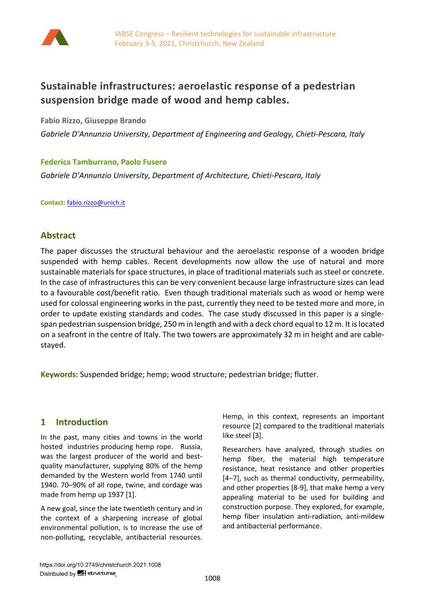Sustainable infrastructures: aeroelastic response of a pedestrian suspension bridge made of wood and hemp cables.

|
|
|||||||||||
Détails bibliographiques
| Auteur(s): |
Fabio Rizzo
(Gabriele D’Annunzio University, Department of Engineering and Geology, Chieti-Pescara, Italy)
Giuseppe Brando (Gabriele D’Annunzio University, Department of Engineering and Geology, Chieti-Pescara, Italy) Federica Tamburrano (Gabriele D’Annunzio University, Department of Architecture, Chieti-Pescara, Italy) Paolo Fusero (Gabriele D’Annunzio University, Department of Architecture, Chieti-Pescara, Italy) |
||||
|---|---|---|---|---|---|
| Médium: | papier de conférence | ||||
| Langue(s): | anglais | ||||
| Conférence: | IABSE Congress: Resilient technologies for sustainable infrastructure, Christchurch, New Zealand, 3-5 February 2021 | ||||
| Publié dans: | IABSE Congress Christchurch 2020 | ||||
|
|||||
| Page(s): | 1008-1016 | ||||
| Nombre total de pages (du PDF): | 9 | ||||
| DOI: | 10.2749/christchurch.2021.1008 | ||||
| Abstrait: |
The paper discusses the structural behaviour and the aeroelastic response of a wooden bridge suspended with hemp cables. Recent developments now allow the use of natural and more sustainable materials for space structures, in place of traditional materials such as steel or concrete. In the case of infrastructures this can be very convenient because large infrastructure sizes can lead to a favourable cost/benefit ratio. Even though traditional materials such as wood or hemp were used for colossal engineering works in the past, currently they need to be tested more and more, in order to update existing standards and codes. The case study discussed in this paper is a single-span pedestrian suspension bridge, 250 m in length and with a deck chord equal to 12 m. It is located on a seafront in the centre of Italy. The two towers are approximately 32 m in height and are cable-stayed. |
||||
| Mots-clé: |
passerelle piétonnne construction en bois
|
||||


